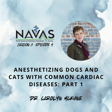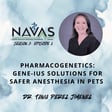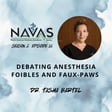
Safety Culture with Dr. Lydia Love - Ep. 9
If you practice medicine long enough, you may find that mistakes can happen despite our best efforts. Although anesthesia is vital to provide appropriate care in many clinical situations, it also has the potential to create adverse side effects, complications, and even life-threatening situations. For this reason, veterinary professionals providing anesthesia services should strive to promote a culture of patient safety within their practices. If this is a concept you have not heard before, or if you are a policy geek who gets excited over checklists, then this episode is for you!
Host Dr. Bonnie Gatson is joined by Dr. Lydia Love, a boarded veterinary anesthesiologist from North Carolina State University College of Veterinary Medicine and a strong advocate for patient safety in anesthetic practice. Together, they will discuss various aspects of patient safety, including what a hospital with a robust culture of patient safety looks like, why safety culture is important for the well-being of both patients and veterinary practitioners and why you need to fill your veterinary practice with checklists.
We invite you to check out articles and checklists that are referenced in the episode, including the original WHO Surgical Safety Checklist, the Association of Veterinary Anaesthetists (AVA) resource on checklists, and the Royal College of Veterinary Surgeon’s site on everything you need to know about implementing a veterinary surgical checklist, which includes examples and templates.
If you like what you hear, we have a couple of favors to ask of you:
- Subscribe to the North American Veterinary Anesthesia Society (NAVAS) for access to more anesthesia and analgesia educational and RACE-approved CE content.
- Spread the word. Share our FB or IG post, re-tweet, post something on a network or a discussion forum, or tell a friend over lunch. That would really help us achieve our mission: Reduce mortality and morbidity in veterinary patients undergoing sedation, anesthesia, and analgesia through high quality and peer-reviewed education.
Thank you to our sponsor, Dechra - learn more about the pharmaceutical products Dechra has to offer veterinary professionals, such as Zenalpha.
If you have questions about this episode or if you want to suggest topics for future episodes, please reach out to the producers of this podcast at education@mynavas.org. Please consider subscribing, liking, leaving this podcast a review, or even telling your friends to give this podcast a listen. We appreciate any and all listener support!
All opinions stated by the host and their guests are theirs alone and do not represent the thoughts or opinions of any corporation, university, or other business or governmental entity.
The NAVAS Podcast is published monthly on or near the 15th of the month.
Special thanks to Chris Webster for editing, producer Maria Bridges and Saul Jimenez for IT support in making this podcast a reality.








